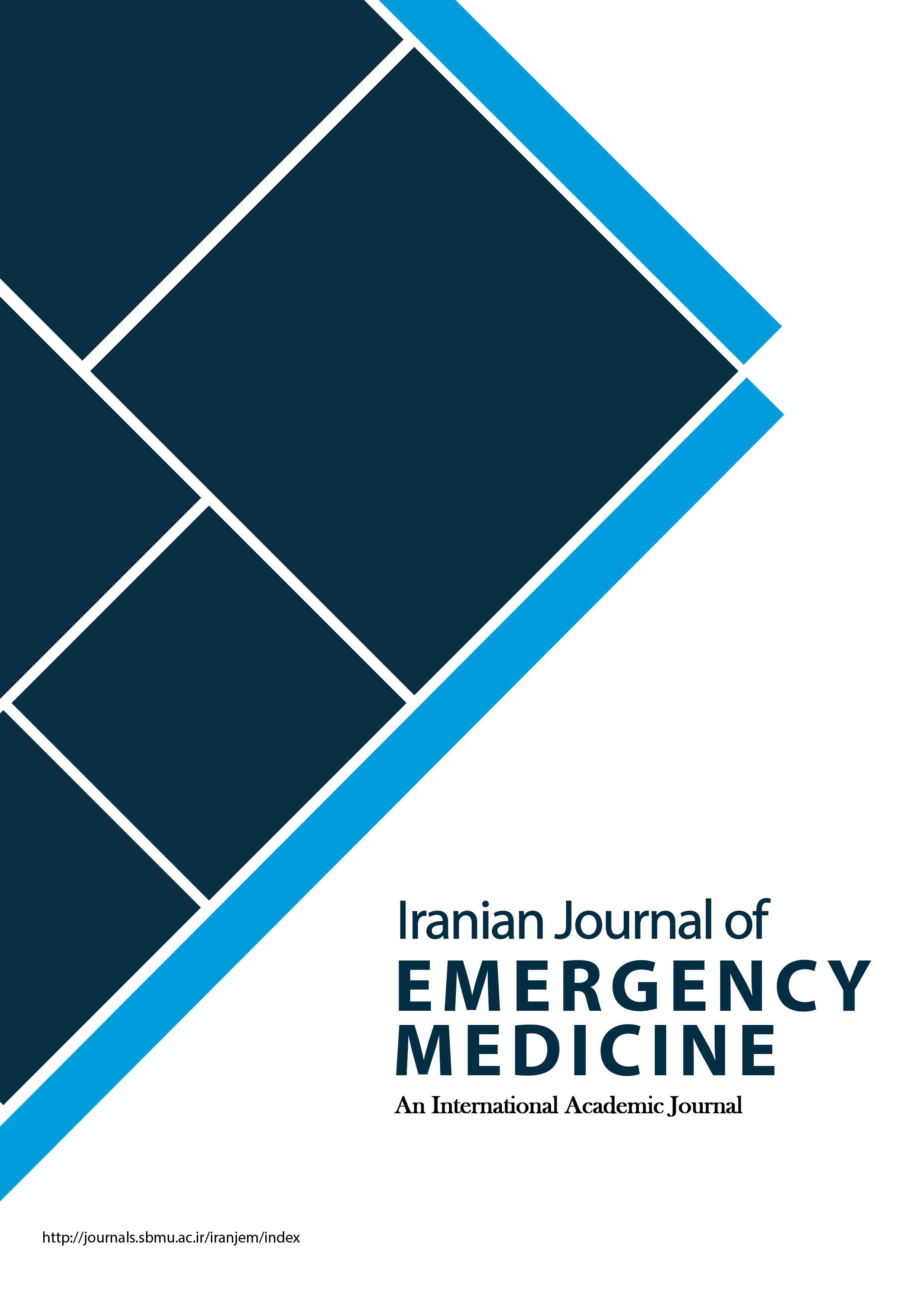Evaluation of Non-emergency Cases Using Emergency Department Services
Iranian Journal of Emergency Medicine,
Vol. 4 No. 3 (2017),
23 June 2017
,
Page 96-91
https://doi.org/10.22037/ijem.v2i1.14437
Abstract
Introduction: Emergency department (ED) has been designed to provide services for patients that are physiologically unstable and need continuous evaluation and treatment according to the process of their illness. Therefore, a major part of critical care is provided for patients in this department. However, a number of patients visiting ED do not need these kinds of services. The present study was done aiming to evaluate the causes of non-emergency cases using ED services. Methods: This cross-sectional study was carried out in ED of Imam Hossein Hospital, Teran, Iran, from August 2014 to August 2015. Convenience sampling was used and all the patients admitted to ED were divided into groups of in need of emergency services and other, based on the algorithm of New York University ED. Cases that visited due to an illness that did not need emergency services based on the evaluations and were in levels 4 and 5 of triage were included in the study after approval of a physician. Data gathering was done by a trained nurse using a pre-designed checklist. Results: In the present study, 1500 patients with the mean age of 40.0 ± 17.34 years were evaluated (54.47% female). Finally, 601 (40.1%) cases were non-emergency visits based on the definitions of this study. Rewriting the prescriptions due to distortion (16.7%) and unavailability of their physician (14.07%) were the most common causes of non-emergency visits to ED. Sex, time of visit and positive past medical history were identified as variables influencing non-emergency referrals. Conclusion: Based on the findings of the present study, it seems that about 40% of visits to the studied ED were non-emergency cases. Rewriting the prescriptions due to distortion and unavailability of their physician were the most common causes of non-emergency visits. Sex and history of illness were found to be effective variables of non-emergency visits.- بخش اورژانس؛ فوریت ها؛ استفاده نابجا خدمات بهداشت
How to Cite
References
Brilli RJ, Spevetz A, Branson RD, Campbell GM, Cohen H, Dasta JF, et al. Critical care delivery in the intensive care unit: defining clinical roles and the best practice model. Critical care medicine. 2001;29(10):2007-19.
Rivers EP, Nguyen HB, Huang DT, Donnino MW. Critical care and emergency medicine. Current opinion in critical care. 2002;8(6):600-6.
Cowan RM, Trzeciak S. Clinical review: Emergency department overcrowding and the potential impact on the critically ill. Critical Care. 2004;9(3):1-5.
Northington WE, Brice JH, Zou B. Use of an emergency department by nonurgent patients. The American journal of emergency medicine. 2005;23(2):131-7.
Guttman N, Zimmerman DR, Nelson MS. The many faces of access: reasons for medically nonurgent emergency department visits. Journal of Health Politics, Policy and Law. 2003;28(6):1089-120.
Pitts SR, Niska RW, Xu J, Burt CW. National hospital ambulatory medical care survey: 2006 emergency department summary. Natl Health Stat Report. 2008;7(7):1-38.
Redstone P, Vancura JL, Barry D, Kutner JS. Nonurgent use of the emergency department. The Journal of ambulatory care management. 2008;31(4):370-6.
Carret ML, Fassa AG, Kawachi I. Demand for emergency health service: factors associated with inappropriate use. BMC Health Services Research. 2007;7(1):1-9.
Weinick RM, Burns RM, Mehrotra A. Many emergency department visits could be managed at urgent care centers and retail clinics. Health Affairs. 2010;29(9):1630-6.
Chen C, Scheffler G, Chandra A. Massachusetts' health care reform and emergency department utilization. New England Journal of Medicine. 2011;365(12):e25.
Uscher-Pines L, Pines J, Kellermann A, Gillen E, Mehrotra A. Emergency department visits for nonurgent conditions: systematic literature review. The American journal of managed care. 2013;19(1):47-59.
Washington DL, Stevens CD, Shekelle PG, Henneman PL,
Brook RH. Next-day care for emergency department users with nonacute conditions: a randomized, controlled trial. Annals of Internal medicine. 2002;137(9):707-14.
Mortensen K. Copayments did not reduce Medicaid enrollees’ nonemergency use of emergency departments. Health Affairs. 2010;29(9):1643-50.
Uscher-Pines L, Pines J, Kellermann A, Gillen E, Mehrotra A. Deciding to visit the emergency department for non-urgent conditions: a systematic review of the literature. The American journal of managed care. 2013;19(1):47.
Sarver JH, Cydulka RK, Baker DW. Usual source of care and nonurgent emergency department use. Academic Emergency Medicine. 2002;9(9):916-23.
Rust G, Ye J, Baltrus P, Daniels E, Adesunloye B, Fryer GE. Practical barriers to timely primary care access: impact on adult use of emergency department services. Archives of internal medicine. 2008;168(15):1705-10.
Cheung PT, Wiler JL, Lowe RA, Ginde AA. National study of barriers to timely primary care and emergency department utilization among Medicaid beneficiaries. Annals of emergency medicine. 2012;60(1):4-10. e2.
Weber EJ, Showstack JA, Hunt KA, Colby DC, Callaham ML. Does lack of a usual source of care or health insurance increase the likelihood of an emergency department visit? Results of a national population-based study. Annals of emergency medicine. 2005;45(1):4-12.
Weber EJ, Showstack JA, Hunt KA, Colby DC, Grimes B, Bacchetti P, et al. Are the uninsured responsible for the increase in emergency department visits in the United States? Annals of emergency medicine. 2008;52(2):108-15. e1.
Gandhi S, Grant L, Sabik L. Trends in nonemergent use of emergency departments by health insurance status. Medical care research and review: MCRR. 2014;71(5):496-521.
Liu T, Sayre MR, Carleton SC. Emergency medical care: types, trends, and factors related to nonurgent visits. Academic emergency medicine. 1999;6(11):1147-52.
- Abstract Viewed: 672 times
- PDF (فارسی) Downloaded: 264 times
- HTML (فارسی) Downloaded: 93 times



